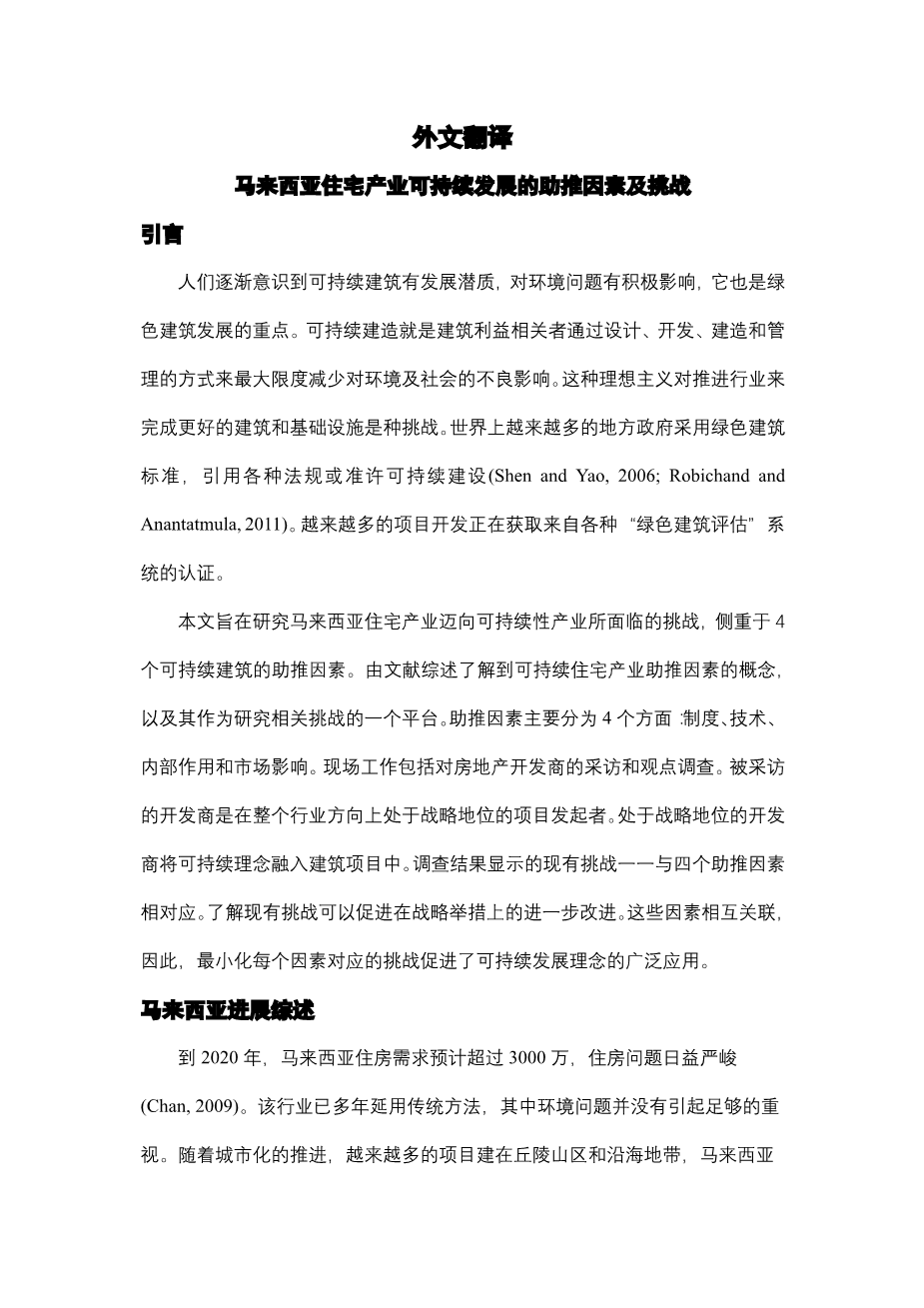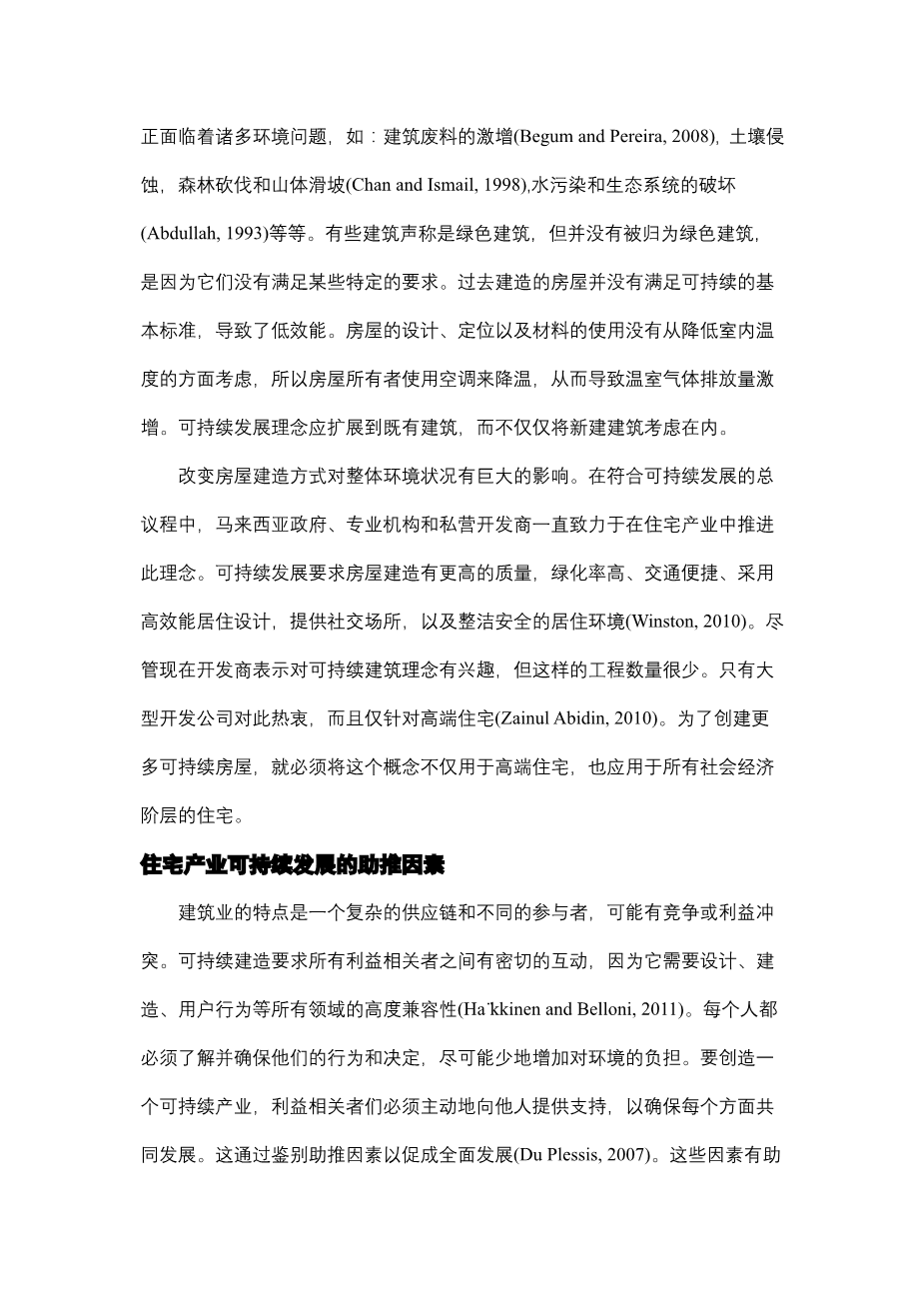Enablers and challenges of a sustainable housing industry in Malaysia
Introduction
The growing awareness of the potential of sustainable construction to positively affect environmental issues is pushing green building to the forefront. Sustainable construction is about the responsibility of the construction stakeholders to design, develop, construct and manage a project in a way that minimises negative impacts on the environment and society. It is an idealism that challenges the industry to deliver better buildings and infrastructure. Worldwide, more local governments are adopting green building standards, introducing various regulations or providing permits for sustainable construction (Shen and Yao, 2006; Robichand and Anantatmula, 2011). More project developments are gaining certifications from various “green building assessment” systems.
This paper aims to investigate the challenges facing the housing industry in Malaysia towards becoming a sustainable industry, by focusing on four enablers of sustainable construction. Through literature reviews, the enablers of sustainable housing industry are conceptualised and served as a platform to discuss the related challenges. The enablers are divided into four sectors: institutional, technological, internal action and market influence. The fieldwork consisting of interviews and surveys focused on the views of housing developers. Developers were selected because they were project initiators having prevailing influence over the overall project direction. Developers have the strategic position to incorporate sustainable concept within the construction projects. The findings of the study are concentrated on the identification of current challenges with respect to the four-quadrant enablers. Knowing present challenges could facilitate and promote strategic actions for future improvement. These enablers are interrelated, thus, the minimisation of the challenges of each enabler is a step closer towards generating wider application of the sustainable concept.
Progress in Malaysia: a review
In Malaysia, the demand for houses is expected to be over 30 million in the year 2020, highlighting serious housing issues (Chan, 2009). The industry has been using conventional methods for many years, where environmental issues were not a major concern. With greater urbanisation and more projects on hillside and coastal areas, Malaysia is facing multiple environmental problems such as an increase in construction waste material generation (Begum and Pereira, 2008), soil erosion, deforestation and landslides (Chan and Ismail, 1998), water pollution and ecosystem disruption (Abdullah, 1993) and many more. There are some buildings which claimed to be green but were not classified as green building because they do not meet certain requirements. Houses being built in the past decades did not meet the essential criteria of sustainability and contributing to energy inefficiency. The design, orientation of the houses and the materials used do not help in terms of cooling the indoor environment which necessitated the occupier to use air-conditioners, hence contributing to more emission of greenhouse gases. The consideration of sustainable concept should be extended to existing buildings and not just new buildings.
Transforming the way houses are built would have a significant impact on the overall environmental condition. In line with the overall agenda of sustainable development, the Malaysian government, professional bodies and private developers have been consolidating efforts to promote this concept in the housing industry. Sustainability demands that houses be built in a higher quality, have access to green space, close to good public transport, using design techniques to increase energy efficiency of dwelling, provide facilities that promote social contact and have a clean and safe residential environment (Winston, 2010). Although housing developers are beginning to show interest on the concept of sustainable construction, the number of such projects is still low. Only big developer companies are keen on it and the target is on high-end houses only (Zainul Abidin, 2010). To create more sustainable houses, it is thus imperative to apply this concept beyond the high cost houses and should cover all socio-economic status housing.
Enablers of sustainable practices in housing industry
The construction industry is characterised by a complex supply chain and various players which may have competing or conflicting interests. To make sustainable construction work, it requires close interaction of all stakeholders because it requires high compatibility of all domains of design, construction and user behaviour (Ha ̈kkinen and Belloni, 2011). Everyone has to understand and ensure that their actions and decisions add as little as possible to the total burden on the environment. To create a sustainable industry, different stakeholders must be proactive and provide supportive actions to others to ensure a collective growth in every facet of the development. This is possible by identifying the enablers to holistic improvement (Du Plessis, 2007). These enablers will be useful to target or strategise improvement at micro level which will have impact on the macro level. Reed (2007) stated that it is necessary to realise how one can participate with the industry to create a whole system of mutually beneficial relationships.
The enablers (institutional, technological, internal action and market influence) are shown in Figure 1. In Figure 1, the enablers are interconnected, although individually characterised. Each enabler has a role to play to create a sustainable housing industry. The institutional enablers stimulate change and development through policies, legislations and many others. However, the changes will not be possible without the support of technology
剩余内容已隐藏,支付完成后下载完整资料


英语译文共 11 页,剩余内容已隐藏,支付完成后下载完整资料
资料编号:[497888],资料为PDF文档或Word文档,PDF文档可免费转换为Word


